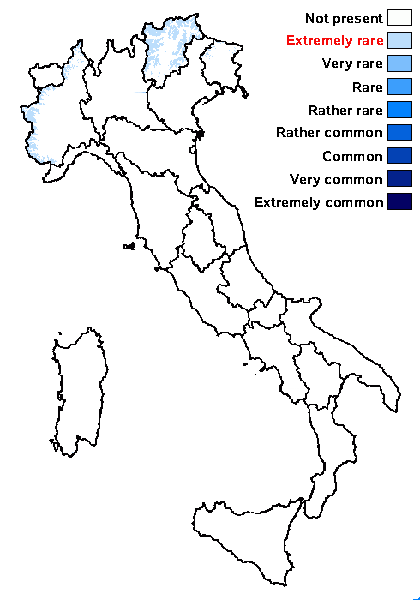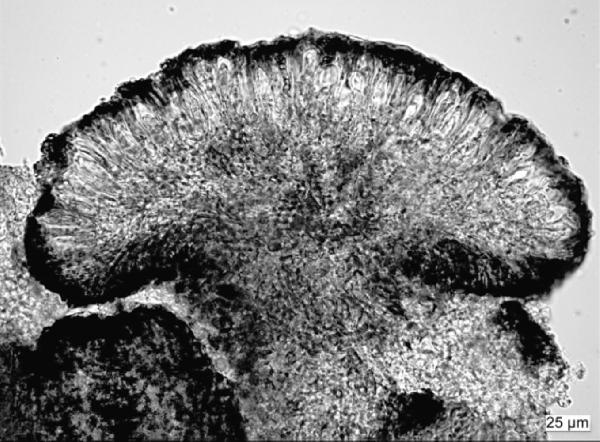Carbonea intrudens (H. Magn.) Hafellner
Fritschiana, 52: 40, 2006. Basionym: Lecidea intrudens H. Magn. - Ark. Bot., 33, A, 1: 53, 1946.
Synonyms: Carbonea halacsyi sensu Hafellner & Sancho non Lecidea halacsyi J. Steiner
Distribution: N - Frl (Tretiach & Hafellner 2000, Hafellner 2006, Brackel 2016), TAA (Hafellner 2006, Brackel 2016, Hafellner 2021, Nascimbene & al. 2022), Piem (Hafellner 2006, 2007, 2021, Hertel & Schuhwerk 2010, Brackel 2016), Emil (Hafellner 2006, Brackel 2016, Fariselli & al. 2020).
Description: Thallus indistinct, doubtfully lichenized, immersed in the thalli of Rhizocarpon-species and other crustose lichens, which often appear darkened or bleached in the infected parts. Apothecia biatorine, black, 0.3-0.5 mm across, broadly attached, often clustered on the edge of the host’s areoles or on its hypothallus, with a soon convex, somewhat glossy disc, without a distinct proper margin. Proper exciple green-black in outer part, dark brown within, 30-50 μm wide, of radially arranged hyphae, K-, N+ orange-brown; epithecium blue green or emerald-green, c. 10 μm high, K+ emerald green, N+ blue; hymenium colourless or greenish in upper part, 40-55 μm high, I+ blue turning red-brown; paraphyses conglutinated, simple or sparingly branched and anastomosing, 2-2.5 mm thick, the apical cell only slightly enlarged and surrounded by blue-green pigment; hypothecium dark brown to brown, 50-120 μm high, K+ purple, N+ orange-brown. Asci 8-spored, clavate, the K/I+ blue tholus penetrated by a faintly amyloid apical cushion with parallel or diverging flanks, the outer wall very thin, K/I-, surrounded by a K/I+ blue outer layer, Lecanora-type. Ascospores 1-celled (rarely old spores 1-septate), hyaline, ellipsoid to oblong, 8-12(-16) x 3-5 μm. Photobiont absent (some authors report an epicapylic thallus with chlorococcoid photobiont). Spot tests: all negative. Chemistry: without lichen substances.Note: perhaps circumpolar-alpine in distribution, this is a doubtfully lichenised, obligately lichenicolous fungus growing on species of Rhizocarpon near or above treeline. For further details see Hafellner (2006).
Growth form: Crustose
Substrata: rocks
Photobiont: green algae other than Trentepohlia
Reproductive strategy: mainly sexual
paras yellow Rhizocarpon species
Commonnes-rarity: (info)
Alpine belt: extremely rare
Subalpine belt: extremely rare
Oromediterranean belt: absent
Montane belt: absent
Submediterranean belt: absent
Padanian area: absent
Humid submediterranean belt: absent
Humid mediterranean belt: absent
Dry mediterranean belt: absent

Predictive model
Growth form: Crustose
Substrata: rocks
Photobiont: green algae other than Trentepohlia
Reproductive strategy: mainly sexual
paras yellow Rhizocarpon species
Commonnes-rarity: (info)
Alpine belt: extremely rare
Subalpine belt: extremely rare
Oromediterranean belt: absent
Montane belt: absent
Submediterranean belt: absent
Padanian area: absent
Humid submediterranean belt: absent
Humid mediterranean belt: absent
Dry mediterranean belt: absent

Predictive model
 INDEX FUNGORUM
INDEX FUNGORUM
 GBIF
GBIF
 DOLICHENS
DOLICHENS


